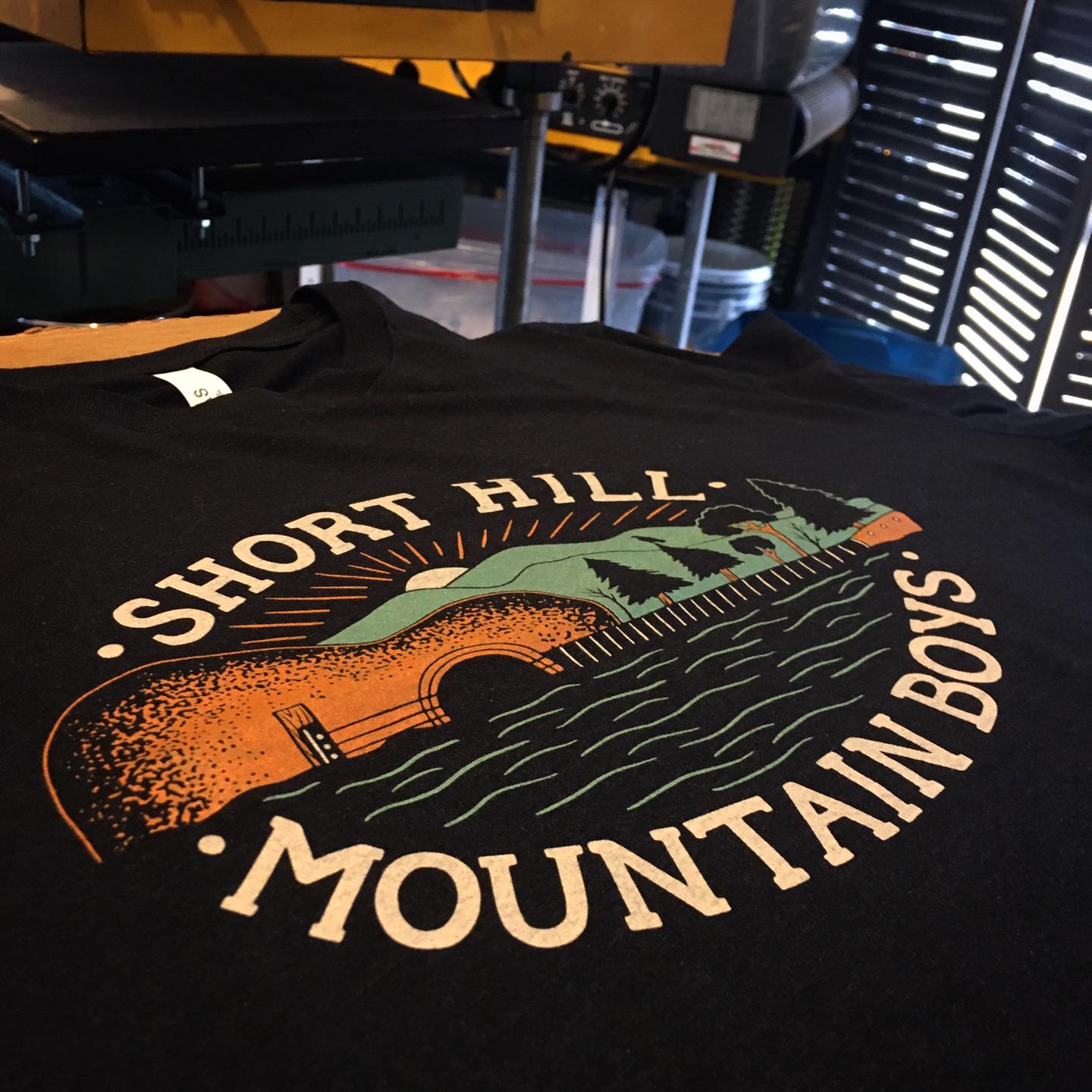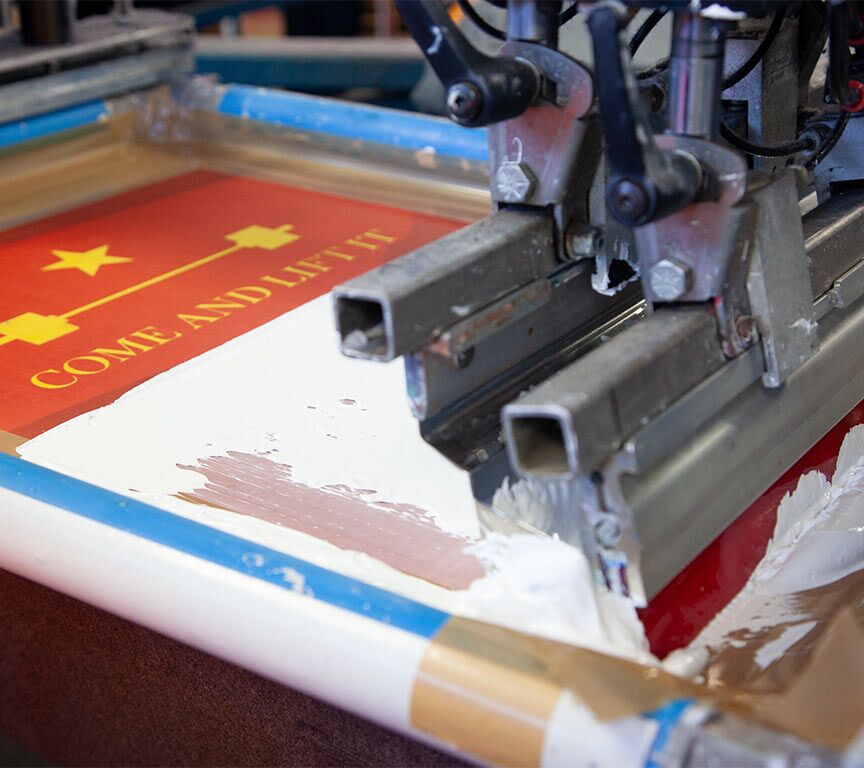High-End Silk Screen Printing for Premium Garments
High-End Silk Screen Printing for Premium Garments
Blog Article
The Ultimate Display Printing Kit: Important Devices for Successful Garment Printing
When it comes to evaluate printing, having the right tools can make all the difference. Your package needs to consist of basics like a sturdy frame, a reliable squeegee, and a quality exposure system. Yet what about the screens and inks? Choosing the appropriate products customized to your specific tasks is vital. You'll quickly find just how these parts interact to raise your printing game. Let's explore what each tool gives the table and exactly how to maximize their possibility.
Understanding Display Printing Basics
When you immerse yourself in screen printing, you'll find it's both an art and a scientific research. As soon as dried, you subject the screen to UV light with your style positioned on top, allowing you to produce a pattern.
Following, you'll establish your printing terminal, aligning your display with the garment. Making use of a squeegee, you'll press the ink through the display, making certain also insurance coverage. The appeal of screen printing hinges on its adaptability; whether you're printing bold graphics or elaborate patterns, the process continues to be the exact same.
As you technique, you'll find out about ink kinds, drying out times, and shade mixing. Each print is a chance to improve your method and share your creative thinking, making screen printing a satisfying undertaking for any person enthusiastic about layout.
Crucial Elements of the Screen Printing Set
To get going with screen printing, you require to understand the crucial elements of your kit. You'll intend to familiarize on your own with the fundamental tools, the kinds of inks and solutions you'll use, and the tools for application. Each element plays a vital function in achieving premium prints on your garments.
Fundamental Tools Review
A fully equipped display printing package is crucial for any individual wanting to develop sensational garment layouts. Start with a durable display printing framework, which holds your mesh tightly for exact printing. You'll likewise need a squeegee to push ink through the mesh onto your textile. Don't neglect the direct exposure unit or source of light, crucial for transferring your layout onto the screen. A washout station assists you clean displays after use, guaranteeing they await your following job. Invest in a registration system to line up multiple shades properly. With these vital elements, you'll have a solid foundation for your screen printing trip and can concentrate on bringing your creative visions to life.
Solutions and inks
After gathering the basic equipment, your next focus should be on solutions and inks, which play a crucial duty in accomplishing resilient and lively prints. When choosing inks, take into consideration water-based, plastisol, or discharge inks based upon the fabric kind and preferred finish. Water-based inks are eco-friendly and soft on garments, while plastisol uses sturdiness and intense colors.
Emulsions, on the various other hand, are important for producing your displays. They assist create the pattern needed for printing - custom screen printing. You'll wish to pick a top quality emulsion that fits your ink kind and exposure approach. Keep in mind to save inks and emulsions effectively to maintain their performance. With the right options, you'll establish the structure for sensational, professional-grade prints.
Tools for Application

Picking the Right Screens for Your Projects
When you're choosing screens for your jobs, the mesh count and framework material are necessary elements to take right into account. A higher mesh matter is wonderful for fine details, while the right structure material can enhance resilience and stability. Understanding these aspects will help you attain the most effective cause your display printing undertakings.
Screen Mesh Count
Picking the ideal screen mesh count is vital to achieving the wanted outcomes in your screen printing jobs. The mesh matter refers to the number of threads per inch in the display, influencing how much ink gets transferred onto your garment. Constantly consider the type of ink and fabric you're utilizing, as these variables influence the mesh count option.
Frame Material Options
The display frame material you choose plays a significant function in the high quality of your prints. You've got a couple of choices to review, each with its advantages. Light weight aluminum frameworks are light-weight, durable, and immune to corrosion, making them ideal for long-lasting use. They supply excellent stress, making sure crisp prints. On the various other hand, wood structures are much more typical and can be more economical, yet click to read more they're much heavier and may warp with time. You may favor light weight aluminum for its dependability if you're just starting. For larger projects, pick frames that can endure the stress needed for fine details. Inevitably, select a product that matches your workflow and budget plan while guaranteeing your prints come out looking professional and sharp.
Selecting Inks for Various Fabrics
How do you assure your screen printing layouts look last and vivid on numerous fabrics? Selecting the best ink is key. For cotton, water-based inks are your best option. They soak into the textile, giving a soft feel and superb toughness. Take into consideration using plastisol inks if you're printing on polyester or artificial blends. They sit on top of the fabric, ensuring intense colors and good bond.
Do not ignore specialty inks like discharge or metallic inks. Release inks can get rid of color useful link from material, leaving a soft print, while metal inks include a glossy surface that stands apart. Always examine your inks on the specific material before devoting to a big run; this assists you assess shade vibrancy and longevity.
Last but not least, remember the textile's weight and texture. Selecting the appropriate ink for each and every fabric type will assure that your layouts not only look wonderful yet also hold up against the test of time.
The Importance of Mops in Printing
Mops play an essential role in achieving top quality prints in screen printing. They're your key device for moving ink via the stencil onto the textile, and the right squeegee can make all the distinction. When you use constant pressure with a squeegee, you guarantee an also distribution of ink, reducing the chances of blotchy or irregular prints.
Selecting the right durometer or solidity of your squeegee is essential, as it affects exactly how much ink is drawn with the mesh. A softer squeegee is terrific for thorough designs, while a stronger one functions well for strong graphics. Furthermore, the size of the squeegee must match your screen dimension to enhance your printing procedure.
Taking some time to grasp your technique with the squeegee will cause cleaner, sharper prints. So, do not underestimate this integral tool-- be familiar with it, browse around these guys and you'll raise your screen printing game.
Preparing Your Artwork and Emulsion
Achieving great prints starts long prior to you get your squeegee. Verify your artwork is high-resolution and formatted appropriately. Usage vector graphics for crisp lines and scalability. When you enjoy with the design, print it on transparency film, bearing in mind that the darker the picture, the much better it blocks light throughout exposure.
Following, choose the right emulsion for your job. Apply it equally to your display in a poorly lit location to stop early exposure. Allow it to completely dry entirely, preferably in a dark area, to ensure superb results. When your display is prepared, reveal it to UV light according to your emulsion's instructions. The light will certainly solidify the emulsion where it strikes, leaving your design unexposed.
After washing out the unexposed emulsion, allow the screen dry totally. With your art work and solution ready, you're established for the printing process!
Upkeep Tips for Lasting Tools
Although it may appear tiresome, normal upkeep of your display printing tools can substantially expand their life expectancy and guarantee consistent outcomes. Beginning by cleansing your screens quickly after use.
For mops, clean the blade after each usage to prevent ink from drying out on it. Routinely examine for nicks or damages and change them as required. Don't forget your direct exposure system-- tidy the glass surface routinely to confirm ideal light direct exposure.

Frequently Asked Questions
Can I Screen Print on Dark Colored Fabrics?
Yes, you can screen print on dark tinted materials! Just make use of a proper nontransparent ink made for dark materials.
Exactly how Do I Clean My Displays After Publishing?
To cleanse your displays after printing, you'll need a stress washer or tube to eliminate excess ink. Then, make use of a screen cleaner or mild cleaning agent with a soft brush to scrub away residue. Rinse extensively.
What Safety Gear Do I Need While Screen Printing?
When screen printing, you'll need gloves to safeguard your hands, a mask to avoid breathing in fumes, and security goggles to secure your eyes from inks and chemicals. Being cautious warranties a delightful and safe experience.
Can I Utilize the Set for Various Other Materials Besides Textile?
Yes, you can utilize the package for various other materials besides textile. It works well on surfaces like timber, paper, and plastic. Simply make certain the ink and strategies suit the product you pick.
For how long Does It Take for Ink to Treat?
Ink typically takes concerning 24 hr to treat fully, yet it can differ based upon the kind and thickness. You'll intend to examine the supplier's guidelines for specific treating times to guarantee excellent results.
Using a squeegee, you'll push the ink with the screen, making sure even insurance coverage. You'll require a trustworthy squeegee, which aids uniformly distribute ink across your display.Selecting the appropriate screen mesh matter is important to attaining the preferred outcomes in your screen printing tasks. The mesh matter refers to the number of threads per inch in the display, influencing how much ink obtains moved onto your garment.To cleanse your screens after printing, you'll need a pressure washing machine or tube to eliminate excess ink.
Report this page